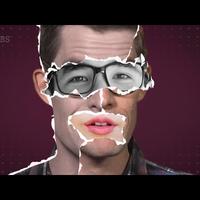Does Someone Else Have Your Face? Doppelgängers Explained!
Oh, hey smart people.
I was just, you know, selfie-ing.
On the Google Arts and Culture app.
It finds your face in famous artworks… your art doppelganger if you will.
Mine is… um, I'm not sure.
But this made me wonder – why do some faces look the same to us?
And how do we even recognize faces?
I mean, there's nearly 8 billion people on Earth… does someone else have your face?
Every day as you scroll through social media, you see dozens, maybe hundreds, of faces.
Your brain analyzes them, and matches them to an identity, without you even consciously
thinking about it.
But what would you do if you were scrolling
through Instagram, and saw your *own* face?
This is Amanda Green.
This is… not Amanda Green.
And this IS Amanda Green again.
I'll let her explain.
Amanda: A couple of years ago I found my look alike.
It was the strangest but most exciting thing that's probably ever happened to me, and now
I have a great story to tell at parties.
A friend of Amanda's saw a picture online that looked like her.
But it wasn't Amanda.
It was someone who shared Amanda's face.
After she posted the photos, the internet found her doppleganger: A girl named Meredith,
from Indiana, who–WOW–looks exactly like her.
At least I think so.
I think it's when it was trending in second place on Buzzfeed, like, under Kim Kardashian that I was like
This is really bizarre.
But after Amanda and Meredith's photos went viral, some people argued that they didn't
actually look alike, because it's the internet, and people will argue about anything.
Some people were like “You guys look absolutely nothing alike. I don't get why
this is even a story” and other people were like “okay, that's the same person who posted twice.”
It was like Yanny and Laurel, but for faces.
Even Amanda's family was divided.
My mom did think we looked alike.
My husband said he couldn't really see it, but he kind of sucks at faces anyways.
So why do people see different things in the same two faces?
Well the answer gives us a clue about what dopplegangers really are: A strange side effect of how our
brains process faces.
So what is a face?
Well “Duh, Joe.
It's the eyes and the mouth and the nose,
and the dimples in the cheeks and the color of the eyebrows”
All these features together create a picture that you present to the world–your face.
But a picture of a face isn't really what your brain sees when you look at someone.
When we recognize anything, we're comparing what we see with a stored “mental picture”
that's encoded in our brain.
Turns out special cells in our brains are active only when we look at faces, and they're
not active when we look at other things.
So what are these facial recognition neurons actually seeing?
This person in Ariana Grande's “Thank U Next” video really looks like Lindsay
Lohan, but it isn't Lindsay Lohan.
Sure her red hair and the “Mean Girls” outfit are part of why we're fooled.
But watch what happens when we overlay their faces.
The geometry of the face, how the features are arranged with respect to one another,
is almost identical, even if the specific features, like the eyebrows and the tip of
the nose, are different.
The same thing is true for Amanda and Meredith.
If you really look at our mouth and nose, it might not look similar, but they're
in like, the exact same place.
Like if you drew lines across your face, my nose, my mouth, and my eyes hit at the exact
same places as hers.
In the areas of our brain that recognize faces, we think certain neurons fire for eyes that are this
far apart, others for a mouth here, or a nose this long.
This combination of nerves firing creates a map, or a code, called a facial schema.
To our brains, a face isn't a picture, it's a pattern.
And if one of those coded patterns shows up somewhere unexpected, we can see a face - even
if it's not there.
It's an effect called Pareidolia.
Take a look at this photo of George W Bush and Dick Cheney.
It's actually George W Bush… and George W Bush.
Did you notice?
Recognize this guy?
Maybe he seems a little familiar, but you can't quite place it?
It's two people - Harrison Ford, and George Clooney.
When they're together, our brains decode them as just one face.
And here are two photos of the same person.
Give them a quick look.
Okay, now let's flip the image.
All of these are examples of how we get fooled, because our brains usually don't pay attention
to the details of faces.
We don't have cameras in our heads.
We're running pattern recognition software between our ears.
And I guess this means we need a firmware upgrade.
Of course, the more time we spend with people, the better we can tell their face apart from
others, because our face software gets help from our long term memory.
Like, we could all tell if the President was replaced by some body double named Dave or something. Right?
You're a very handsome man. Thank you Mr. President.
You come for the science, but you stay for the very current pop culture references.
But if you don't know two people, like Meredith and Amanda – you're more likely to think
they look alike.
Researchers at Cambridge University developed a face memory test that you can take for yourself.
As it turns out, I am very good at remembering new faces.
And speaking of remembering faces, did you notice we just switched Amanda and Meredith's
photos?
Some people are just better at facial recognition than others, and scientists don't really
know why.
People who don't think Amanda and Meredith look alike are probably able to sense details
in their face patterns that others can't.
But what if someone's life depended on your ability to recognize and tell faces apart?
Would you trust yourself?
That's exactly what Dr. Teghan Lucas does.
She is a professional face identifier.
Or, more accurately, a forensic anthropologist who specializes in facial anatomy.
If police need to identify someone from an image, they turn to her for help.
Teghan: To the naked eye, these people may seem to look the same, and then if you call
someone like me in, we would be able to tell slight differences between them, because we're
trained to look for very, very miniscule things.
Let's imagine a face as a Rubik's cube.
It might seem like you can only get so many combinations of nose, eye, and mouth shapes
before you get a duplicate.
That's something that my researchers and I talk about - probabilities
of facial characteristics and body characteristics - you know - the probability of finding
two people with the same face or two people with the same body.
And we found that these probabilities are comparable with DNA and fingerprints.
So our face is just as unique as a fingerprint or as DNA.
If we factor in just 8 facial measurements, the odds of two people having the same face
are about 1 in a trillion.
So, basically impossible.
If I look at a nose, and I see maybe wide or skinny, or how much it sticks up.
Dr Lucas sees nose width, bridge width, tip size, tip shape, tip angle, angle in relation
to the chin, the forehead, how much a nose protrudes … she nose her stuff.
Even if you take something as simple as the ear, the ear is unique between each
and every individual.
And there's enough anatomical characteristics on the ear that we can identify someone from
the ear.
And I've had cases of that.
Someone has robbed a bank with a balaclava that was on completely the wrong way, and
his ear was showing, and we matched them up.
And you know I asked her about the David Schwimmer look-alike thief.
Yeah, I picked quite a few differences, mostly in the nose - and he had very square chin,
the David Schwimmer lookalike.
And when I looked at it, it was sort of like - oh yeah - I could put this to rest in 5 minutes.
So I asked her to compare Amanda and Meredith.
Here's what she found
So Amanda had a triangular eyebrow shape - meaning she had a bit of an arch in the most superior corner of the eyebrow.
Where as Meredith had a straight eye brow.
Amanda had an oval face shape.Whereas Meredith had a more elliptical face shape.
Amanda had a V shaped upper lip. But in Meredith, she has what we call a cupid's bow.
Meaning, they project upwards but they're more rounded
And Amanda had a rounded bottom lip. Whereas Meredith had a W shaped bottom lip.
So it kind of had those points, but on the bottom.
In Amanda, she had what we all a nasolabialis fold.
It's these folds here.
And she's got them quite prominently even when she doesn't smile.
Whereas Meredith doesn't have those folds at all. Unlike Amanda.
Dopplegangers are never identical matches, but they don't have to be to cause problems.
Dr. Lucas is working on a case right now involving someone who's been in prison for over a
decade, maybe by mistake, because their face might look enough like someone else's.
Facial recognition is very unreliable.
And in that moment, when you're actually calling upon someone to recall their memory
- entirely unreliable.
So if we get fooled so often, maybe computers could do better than humans?
But I don't know. Computers can see a face in someone's knee.
Or the was the time that an automated surveillance system in China publicly shamed a woman for jaywalking after
seeing her face on the side of a bus.
But what if we let computers teach themselves how to recognize faces?
Maybe they could get fooled less than we do.
Why don't you try to find the matching photo?
A computer can do this almost instantly.
A company called Thorn developed this software to help find missing kids.
Ruben: We've been able help investigators identify about 8 kids every day.
Thorn fed stacks of images into a machine intelligence, and let it learn over time,
until it was able to identify where a face is, pick out its important features, and match
similar faces together.
What I find most interesting is that they didn't train it to see faces like we do.
It's evolved its own way of recognizing faces, just like our own brains evolved neural
networks that help *us* recognize *each other*.
But where computers - machine intelligence
really makes a difference is that it's capable of memorizing such a large number of people.
I think a human being can remember at most, let's say 5,000 faces.
For a computer it's pretty straight forward , the help of machine intelligence to even memorize a million people, or several million people.
The AI isn't perfect, but neither are our own abilities.
But our powers combined can have serious potential.
If we think of a face like a lost needle, AI makes the haystack way smaller from the get-go.
Yeah and I think that's really where we're mostly going towards,
like 5 million faces, where is this one particular person.
And enable us to do things we're unable to do ever before.
That's very exciting.
So, science tells us that technically doppelgangers don't exist.
Every face that's ever been is unique – yours, mine, even between identical twins.
But science has also shown us that we're really good at fooling ourselves.
Even when something is right in front of our face.
Stay curious.

